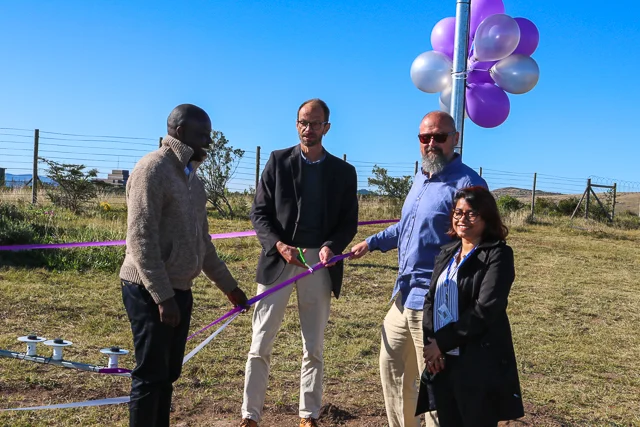
Dean of Science Professor Tony Booth officially launched the Rhodes University Transient Array Radio Telescope (TART) at the Waainek (Makhanda) site last week.
The building and deployment of a TART at Rhodes University is a collaborative effort between Rhodes University, the University of Otago, and Stellenbosch University.
The TART design for a highly low-cost, open-source 24-element radio interferometer was initially developed by Dr Tim Molteno and his group at the University of Otago to provide a test-bed for developing and testing state-of-the-art calibration and imaging algorithms for radio astronomy.
This initiative originates from early brainstorming in 2021 between SKA Research Chair (Centre for Radio Astronomy Techniques and Technologies) Professor Oleg Smirnov, Physics Lecturer at Rhodes University Dr Stanley Kuja, Rhodes University Mathematics Lecturer Dr Patrice Okouma, and University of Otago Senior Lecturer of Physics Dr Tim Molteno.
This project also has the full support of the Head of the Physics & Electronics Department at Rhodes University, Professor Makaiko Chithambo, and Chief Technologist at the Square Kilometre Array (SKA) and Rhodes University Physics Professor Justin Jonas.
Dr Kuja, as project lead engineer, oversaw the installation and testing of the TART with the assistance of two brilliant young graduates, Rikus Human from Stellenbosch University and Sonia Ghosh from the Raman Institute in India, who is currently an intern at Rhodes University.
A particular innovation of the Rhodes University group was the layout of this version of the TART, which consists of 24 movable antennas mounted along three beams arranged in the shape of a Y. This layout echoes the iconic Very Large Array (VLA) radio telescope (New Mexico, US), both in the shape and reconfigurability.
TART as a teaching tool
At Rhodes University, the TART will provide an excellent platform for student training, research in machine learning, electromagnetic compatibility (EMC) metrology, and community engagement in the form of STEM consolidation for Makhanda’s schoolgoers as a collateral benefit.
In addition, the TART will give Rhodes University students early exposure to the entire value chain of the SKA. The SKA is a significant long-term international science and technology project in which South Africa has the lion’s share.
Until recently, the typical immersion of mathematics and computer science graduate students into engineering has been minimal. The full deployment of a TART at Rhodes University will provide an avenue toward a holistic immersion into research and development early on.
Continuous research and development on the electronic systems of the TART present further training opportunities for staff and graduates and pathways towards costing the current capital expenditure on TART, including operational costs. In the current setup, Rhodes University provides the required infrastructure (electrical power, internet, and a secure site at Waainek), managed by the Director of the Centre of Biological Control (CBC), Professor Martin Hill and the Waainek Research Facility Manager, Samella Ngxande-Koza.
Tlaba Mochebelele is Rhodes University’s first postgraduate student to work on data from the Waainek TART and its pathfinders at Stellenbosch University and the University of Otago.
According to Dr Okouma, “This setup will lay the ground for the intake of more postgrad students since TART provides data of significant value for testing various mathematics-based algorithms for radio interferometry as well as full-fledged state-of-the-art techniques in Machine Learning.”
The low-cost but powerful capabilities of the electrical components of the TART extend the opportunities for the “break and rebuild” electronics approach for teaching and learning purposes. “Since radio frequency interference (RFI) is a major concern in radio astronomy, intelligent techniques in characterising RFI at the Waainek site can be transferred to the SKA-MeerKAT project,” said Dr Kuja.
“It’s a perfect instrument for learning and experimentation,” said Prof Smirnov about the TART. “Our South African flagship, MeerKAT, can be a little intimidating for students – competition for time is stiff, data volumes are huge, and the instrument itself is at a remote Karoo site. The TART is right here; it is very hands-on, and data is freely available to all.”
Hands-on experimentation offers a robust training experience for all ages. In the case of TART, radio interferometry and its congruent fields present a versatile operational landscape for the learning experience at all stages for any learner interested in science.

